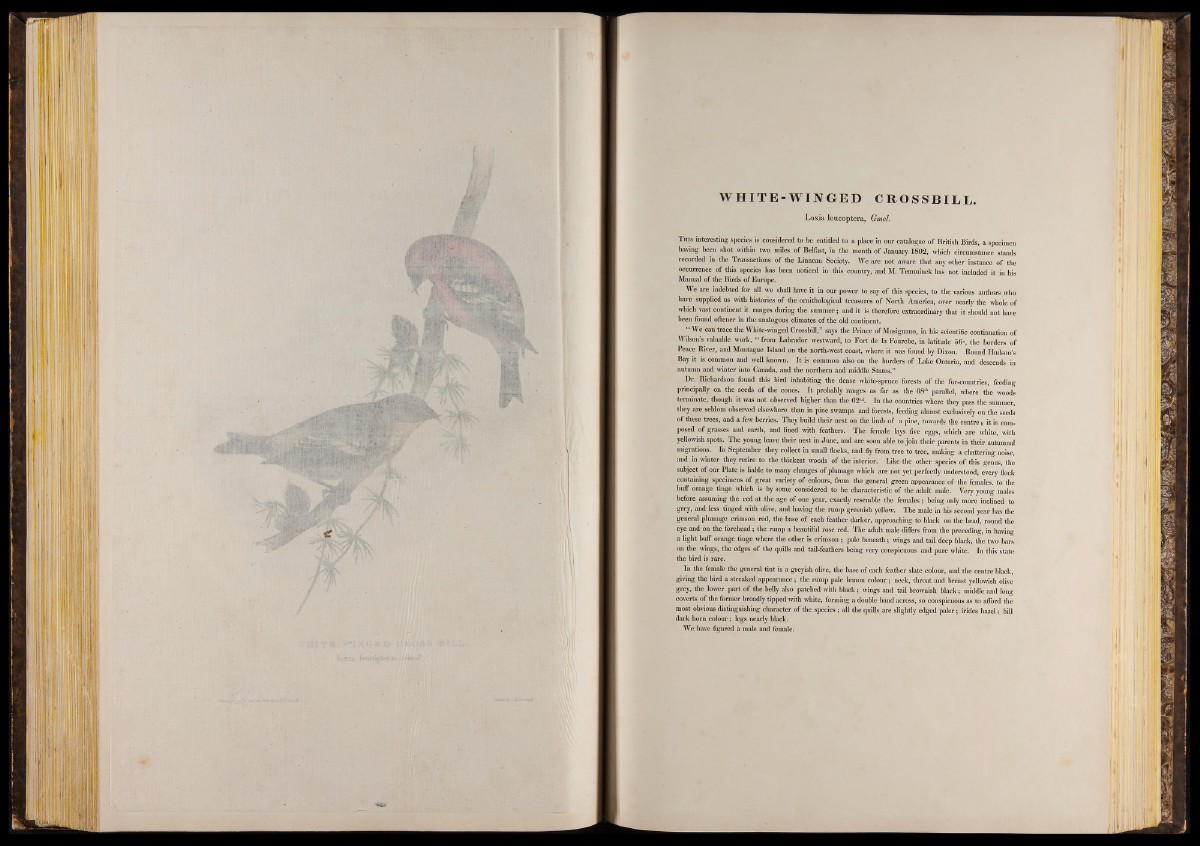
i
■
■
mm MP'' 1
m
t i
111 I
W H I T E -W I N G E D CROS SB IL L .
Loxia leucoptera, Gmel.
This interesting species is considered to be entitled to a place in our catalogue o f British Birds, a specimen
having been shot within two miles o f Belfast, in the month o f January 1802, which circumstance stands
recorded in the Transactions o f the Linnean Society. We are not aware that any other instance of the
occurrence o f this species has been noticed in this country, and M. Temminck has not included it in his
Manual of the Birds of Europe.
We are indebted for all we shall have it in our power to say o f this species, to the various authors who
have supplied us with histories of the ornithological treasures of North America, over nearly the whole of
which vast continent it ranges during the summer; and it is therefore extraordinary that it should not have
been found oftener in the analogous climates o f the old continent.
“ We can trace the White-winged Crossbill,” says the Prince o f Musignano, in his scientific continuation of
Wilson's valuable work, “ from Labrador westward, to Fort de la Fourche, in latitude 56°, the borders of
Peace River, and Montague Island on the north-west coast, where it was found by Dixon. Round Hudson’s
Bay it is common and well known. It is common also on the borders of Lake Ontario, and descends in
autumn and winter into Canada, and the northern and middle States.”
Dr. Richardson found this bird inhabiting the dense white-spruce forests of the fur-countries, feeding
principally on the seeds of the cones. It probably ranges as far as the 68'1 parallel, where the woods
terminate, though it was not observed higher than the 62“>. In the countries where they pass the summer,
they are seldom observed elsewhere than in pine swamps and forests, feeding almost exclusively on the seeds
of these trees, and a few berries. They build their nest on the limb of a pine, towards the centre ■ it is composed
of grasses and earth, and lined with feathers. The female lays five eggs, which are white, with
yellowish spots. The young leave their nest in June, and are soon able to join their parents in their autumnal
migrations. In September they collect in small flocks, and fly from tree to tree, making a chattering noise,
and in winter they retire to the thickest woods o f the interior. Like the other species of this genus, the
subject ofour Plate is liable to many changes of plumage which are not yet perfectly understood, every flock
containing specimens of great variety of colours, from the general green appearance of the females, to the
buff orange tinge which is by some considered to be characteristic o f the adult male. Very young males
before assuming the red at the age o f one year, exactly resemble the females ; being only more inclined to
grey, and less tinged with olive, and having the rump greenish yellow. The male in his second year has the
general plumage crimson red, the base of'each feather darker, approaching to black on the head, round the
eye and on the forehead; the rump a beautiful rose red. The adult male differs from the preceding, in having
a light buff orange tinge where the other is crimson ; pale beneath; wings and tail deep black, the two bars
on the wings, the edges of the quills and tail-feathers being very conspicuous and pure white. In this state
the bird is rare.
In the female the general tint is a greyish olive, the base of each feather slate colour, and the centre black,
giving the bird a streaked appearance; the rump pale lemon colour; neck, throat and breast yellowish olive
grey, the lower part of the belly also patched with black; wings ahd tail brownish black; middle and long
coverts of the former broadly tipped with white, forming a double band across, so conspicuous as to afford the
most obvious distinguishing character of the species; all the quills are slightly edged paler; irides hazel; bill
dark horn colour; legs nearly black.
We have figured a inale and female.